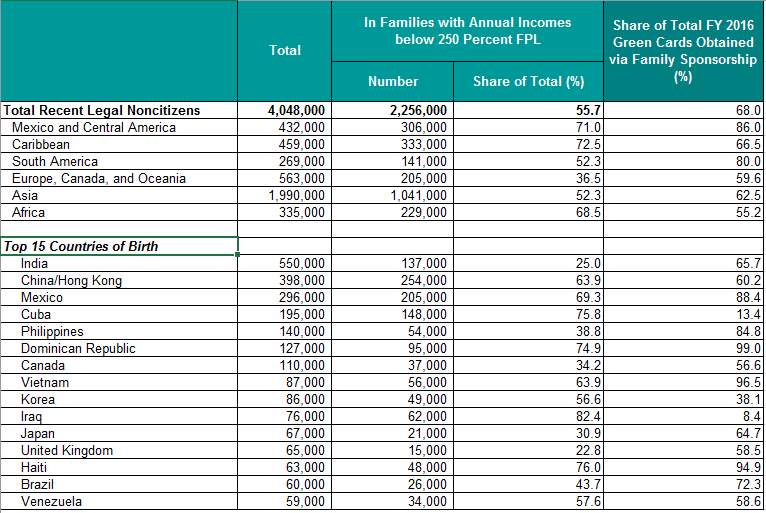MPI Analysis Finds Trump Administration Could Significantly Reshape Future Legal Immigration by Executive Fiat with Expected Public-Charge Rule
Effects Would Fall Most Heavily on Asian, Hispanic and African Immigrants
WASHINGTON – A Trump administration “public charge” rule expected to be unveiled soon could create the potential to significantly reshape family-based legal immigration to the United States—and reduce arrivals from Asia, Latin America and Africa—by imposing a de facto financial test that 40 percent of the U.S. born themselves would fail, the Migration Policy Institute (MPI) finds in a new analysis.
Much attention has been paid to the proposed rule that would dramatically expand the list of public benefits and services that could trigger a “public charge” determination, preventing immigrants from getting a green card or renewing a non-immigrant visa. MPI has previously estimated that 47 percent of the non-citizen population in the United States could be at risk of a public charge determination under the latest leaked draft of the proposal, up from the current 3 percent.
While much has been written about the “chilling effects” the proposal could have on use of public benefits by immigrants or their legal dependents—including U.S. citizens—less attention has been given to the ways in which it could permit the administration to implement a back-door overhaul of the legal immigration system, without needing to go through Congress.
Under a leaked draft circulated in March, the administration would have enormous discretion to deny admission or green cards to those with incomes or financial assets below 250 percent of the poverty line, or around $62,000 annually for a family of four. In a new analysis out today, MPI finds that 2.3 million of the 4 million legally present non-citizens who arrived in the past five years—or 56 percent—live in families with income below 250 percent of the poverty level. (As data are not available on income levels of noncitizens with pending visa applications, the researchers used recently arrived immigrants as a proxy.)
“The introduction of this 250 percent standard would have pronounced regional, national-origin and—by extension—racial effects on flows,” the MPI researchers write. Seventy-one percent of Mexican and Central American, 69 percent of African and 52 percent of Asian immigrants would fail to meet this threshold—as compared to just 36 percent of immigrants from Europe, Canada and Oceania.
Asians, who comprise a growing share of new arrivals, would be the most disadvantaged group numerically under the proposed income standards: More than 1 million recent legal noncitizens from Asia live in families who fail to meet this possible threshold.
Table 1. Number and Share of Recently Arrived, Legally Present Noncitizens in Families with Annual Incomes below 250 Percent of the Federal Poverty Line (FPL), by Region and Top Countries of Birth (2014-16) and Share of Green Cards Obtained in Fiscal Year (FY) 2016 via Family Sponsorship

Note: Recently arrived legally present noncitizens are persons with green cards or legal nonimmigrant visas who came to the United States in the five years prior to the survey.
Sources: Data in the first three columns are from MPI analysis of pooled 2014-16 data from the U.S. Census Bureau’s American Community Survey and 2008 Survey of Income and Program Participation with MPI legal status imputations; data on the share of green cards in fiscal year (FY) 2016 received based on family ties are from the Department of Homeland Security (DHS) Office of Immigration Statistics, Yearbook of Immigration Statistics 2016, Table 10, www.dhs.gov/immigration-statistics/yearbook/2016.
“While it is not possible to know in advance how the Trump administration would exercise its discretion, it is clear that the approach taken in the draft rule would provide extraordinary latitude that could readily be used both to sharply alter legal immigration flows and to tilt the criteria for admissions and green cards away from family-based admissions and individuals unable to meet the 250 percent threshold,” the researchers conclude.
Read the commentary here: www.migrationpolicy.org/news/through-back-door-remaking-immigration-system-expected-public-charge-rule.
# # #
The Migration Policy Institute (MPI) is an independent, non-partisan, non-profit think tank in Washington, DC dedicated to analysis of the movement of people worldwide. MPI provides analysis, development and evaluation of migration and refugee policies at local, national and international levels.

